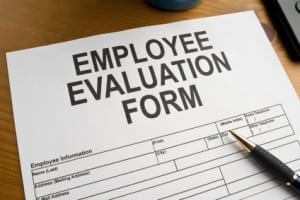The Dual Scale performance appraisal is rarely used but offers a significant improvement to single scale employee evaluation.
Single-Scale performance appraisals can lead to misinterpretation of feedback to employees. They offer a look at one “gap.” For example, let’s say a rater gives an employee a “3” on a 1 to 5 scale where “1” equals consistently missed expectations and “5” equals consistently exceeds expectations. In most cases a “3” on single scale suggests average performance. At best it suggests meeting expectations. A “gap” between meets and exceeds expectation is only implied.
 The single scale assessment lacks the rater’s expectations of performance and misses an important context for the ratings of current behavior. Without knowing the rater’s expectations and priorities, it is not enough information to help the employee create meaningful action plans.
The single scale assessment lacks the rater’s expectations of performance and misses an important context for the ratings of current behavior. Without knowing the rater’s expectations and priorities, it is not enough information to help the employee create meaningful action plans.
Let’s look at a specific example: Set high standards for her/his own work performance. On a single scale, a rating of 3 suggests the employee is just average and meeting expectations. The assumption based on this rating would be that the employee needs to improve his performance.
The Dual Scale performance appraisal however provides another dimension. For example what happens if the rater feels that a 3 or lower is adequate for this particular competency or behavior. If the rater gives a rating of 3 for performance but also gives a 3 for expected performance, a gap of zero is reported. In essence, the rater is satisfied with the subject’s performance although there might be some room for performance.
With a single-scale survey, the subject doesn’t have enough information to prioritize an action and in many cases, attempts to fix everything or focus on the lowest ratings.
Compare those results with the following behavior: Demonstrates a consistent commitment to quality.
If the rater gives a rating of 3 for performance but a 5 for expected performance, the signal is loud and clear. The employee’s performance is merely average but the rater feels it must be better.
With a Dual Scale survey, raters help subjects focus on the behaviors and competencies that are most important. In the examples above, it would be much more important for the employee to improve his quality than set higher standards. This helps discussions move from defensiveness in action planning to focused improvement plans. The message that “managers or other raters want more (or less) of a practice” is easier for a person to understand, to accept and to respond.
More about Gap Size
Gap Size is the numeric difference between how often a behavior occurs and how often the behavior is expected or needed. It is the difference between what the person believes is occurring now and what is needed or expected.
In Perception 360, Gap Size is the numeric difference between “how often a behavior occurs” (Question 1) and”how often the behavior is expected or needed” (Question 2).
The smaller the Average Gap Size, the greater your effectiveness. The larger the Average Gap Size, the greater the desire for change. Below is a sample guide to evaluate Gap Size:
Gap of 0 = Exceptional Performance
Gap of 1 = Acceptable Performance
Gap of 2, 3, or 4 = Strong Desire for Change
